| Peanuts are rightly associated with the Deep South, with Africa, and in brief: warm regions. Seattle is among the cooler summer cities in the entire U.S. Whereupon growing peanuts here is certainly not commercially viable, probably not even worthwhile as a home gardening project, and maybe a candidate for dumb idea of the year. But I am going to try. Let me share with you why. |
| If every human invariably did just what his or her peers did, civilization would not advance; it would "tread water." Everyone would be keeping up with the Joneses --but no one would leap ahead of the Joneses. It is only by risking failure, ridicule, loss, and hurt, that we can --now & then-- succeed in learning something new and worthwhile. In other words: nothing ventured, nothing gained. |
| As for peanuts in Seattle, I already know from book learning, personal testimony, and having seen them growing here, that their cultivation is possible. What I desire to test, using 5 cultivars, is their relative merits, both as nut producers and as to the quality of their edible greens. Moreover, the Old Farmer's Almanac predicts that this region will experience warmer than average May through October. So, this seems like a good year. |
| The cultivated peanut, Arachis hypogæa L., is a allotetraploid that arose in South America, where it was cultivated by least 3,800 years ago (maybe 7,600); it is also grown widely in the Old World in tropical, subtropical and warm-temperate regions --especially in semi-arid climates. Now it is one of the world's main food crops. Other names include Ground Nut, Earth Nut, Monkey Nut, Grass Nut, Goober and Pindar. There are about 75 species of Arachis, all South American. The common peanut plant is prized above all for its oil-rich seeds. Peanut oil has a high smoke point, so you can fry in it at hotter temperatures than olive oil, for example. And though peanut greens are mostly used only for animal fodder, humans can eat them. For a detailed account, see Journal of Food Composition and Analysis Vol. 9, No. 4 (Dec. 1996): Nutrients and Antinutrients in Peanut Greens. A curious side-effect, is that the young shoots and leaves are somewhat sedative; people with insomnia have taken peanut leaf tea with good effect. |
| Since peanuts are so familiar, I will not describe them. Virtually all of us know them --especially those people who are allergic to them. If peanuts get moldy, they also can become carcinogenic. Peanuts were introduced to Africa and China in the early 1500s by Portuguese traders. They were brought to Spain by 1574; to the U.S. by slaves in the 1700s --if not 1600s. It was grown in England by 1712. The modern scientific name Arachis hypogæa, dating from 1753, was a mere renaming of John Ray's name in History of Plants 1686. |
| There are different groups of peanut cultivars. Most are more erect, some prostrate, sprawling, creeping or vining. Some make seeds richer in oil, others less. Some require more heat units in summer, others less. Obviously, nut size and skin color vary, as does shell thickness. I desired --ideally-- to obtain cultivars that were most likely to succeed in Seattle. An internet search reveals that buying raw peanut seed online for home gardeners, is sadly limited. Most cultivars are off limits except to big farmers. After all, peanut is essentially more akin to a grain crop than considered a back-yard vegetable species. The largest selection --still paltry-- is at Southern Exposure Seed Exchange of Virginia (www.southernexposure.com). |
Peanuts need warmth. The soil generally preferred is looser, more sandy, and well drained. Low, soggy, soil, is worst. In summer, regular watering is needed from rain or people. I am planting mine in a specially prepared garden bed, where I dug the soil to a depth of 2 feet, removed over 600 pounds of rocks and roots, added fertilizer, lime and compost. It was time consuming and difficult.
|
The 5 Peanut cultivars I will trial are:
|
| 'Early Spanish' |
| Arachis hypogæa ssp. fastigiata var. vulgaris Harz |
| 105 days. Upright; compact. Higher in oil content. Nuts tiny. Pre-1910 heirloom. |
Unlike the following 4 seeds, these --alas!-- were bought non-organic, from Henry Field's, and were treated with captan, trifloxystrobin, and metalaxyl. And though ordered the same day, they arrived later. I sowed the first batch on May 29th, and when the other 4 (sown May 26th) were planted on June 6th, the 'Early Spanish' still had not sprouted. So I have sowed another batch, and meanwhile have marked with bamboo sticks their places in the garden bed.
|
| 'Schronce's Deep Black' |
Upright. Selected since 1980 by Gordon Schronce of North Carolina. Likely a selection from the following cultivar. The seedlings look identical but darker foliaged.
|
| 'Tennessee Red' (also called 'Tennessee Red Valencia') |
| Arachis hypogæa ssp. fastigiata Waldr. var. fastigiata |
110-120 days. Upright to 2 feet or more. Pre-1890 heirloom.
|
| 'Texas Red and White' |
Dwarfish; 1 to 3 feet tall. Heirloom? Likely a Spanish type. Mine were slower to germinate, and smaller than the previous pair.
|
| 'Virginia Jumbo' ('Mammoth Virginia') |
| Arachis hypogæa ssp. hypogæa var. hypogæa |
120-135 days. Runner; 1.5 feet tall by 3.5 feet wide. Nuts huge. Pre-1895 heirloom.
|
| Stephen Facciola's 1998 book Cornucopia II, lists a dozen more. A person in search of peanuts to plant can always go to a whole foods market in search of raw, unroasted, unsalted peanuts in the shell. But if you care to know the cultivar name of your peanut, that method is imperfect. |
| I plan to photograph and document my crop's progress --and periodically update this web-page. If you attend the Montlake Garden Tour on Saturday, June 16th, you can see my seedlings then. I planted them (4 out of the 5 kinds) June 6th (though the morning temperature was only 55.8 degrees F) in an irregular shaped garden bed that is less than 40 square feet, spaced to fit 45 plants --9 of each cultivar, as shown in photo. The close spacing is suggested in the book by John Jeavons titled How to Grow More Vegetables. The 'Virginia Jumbo' plants get more space, and are near the edge where the brick facing will supply them extra radiated warmth. |
| On July 24th, I noticed flowers on all 9 of the Tennessee Red plants, 3 Schronce's Deep Black, and 2 Early Spanish. |
| On July 28th, Virginia Jumbo began flowering. By July 30th, the Texas Red & White plants were smallest, and only one was blooming. Between September 13th and October 7th, 5 Texas Red & White plants grew yellow and looked wilted, so I plucked and discarded them. Two Tennessee Red plants also looked bad by early October, so were plucked. A weed of Hibiscus Trionum popped up, and I left it because its bears lovely flowers. |
On November 7th, I dug up all that remained in the bed. Only a few Virginia Jumbo and Early Spanish had any nuts; they were few, small, and none turned out to be ripe. Hence, a total crop failure. But of the 4 plants I had planted in black plastic 5-gall. pots, one specimen of Early Spanish set at least two good-looking nuts (see photo below), at least one of which was ripe. I noticed that many of the plants looked rootbound, suggesting that I kept them too long in the flats, before planting them out. But the ground had been too cold to set them out earlier. The lessons that this project taught me about peanut growing in Seattle, are: use Virginia Jumbo and Early Spanish; use black plastic pots; plant directly rather than using flats. And be prepared even then for a tiny yield.
Back |
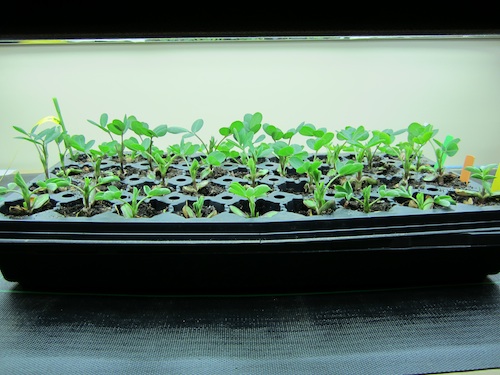
peanut seedlings under lights inside; photo by ALJ
|

peanut bed June 6th; photo by ALJ
|
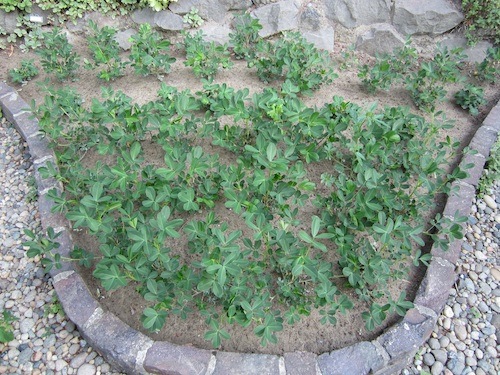
peanut bed August 30th; photo by ALJ
|
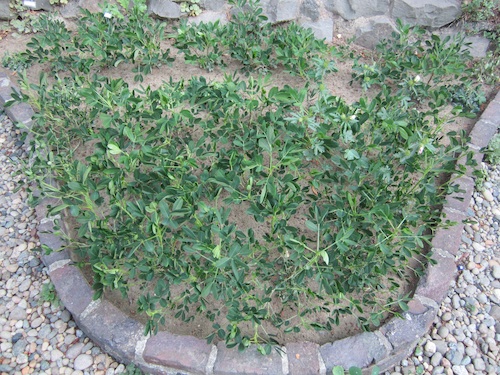
peanut bed October 4th; photo by ALJ
|

peanut bed layout plan; made by ALJ
|
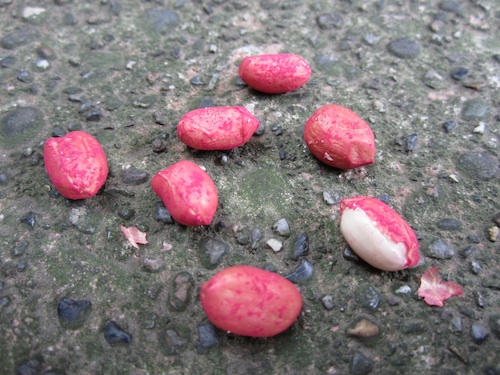
Early Spanish peanuts; photo by ALJ
|
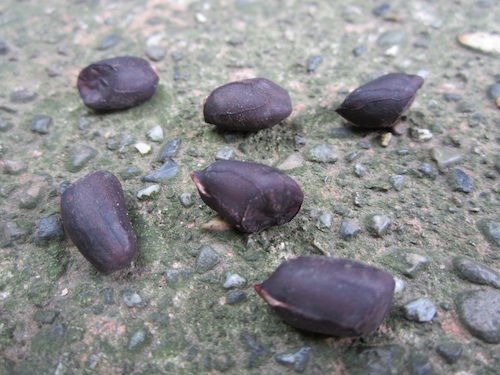
Schronce's Deep Black peanuts; photo by ALJ
|

Tennessee Red peanuts; photo by ALJ
|
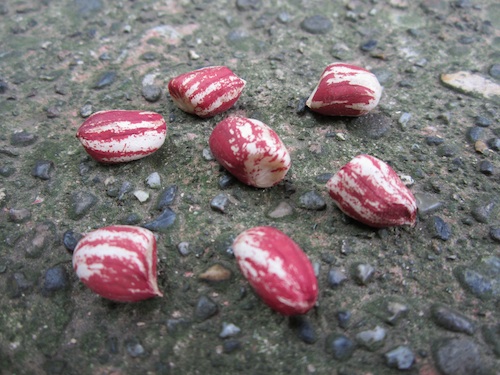
Texas Red and White peanuts; photo by ALJ
|

Virginia Jumbo peanuts; photo by ALJ
|
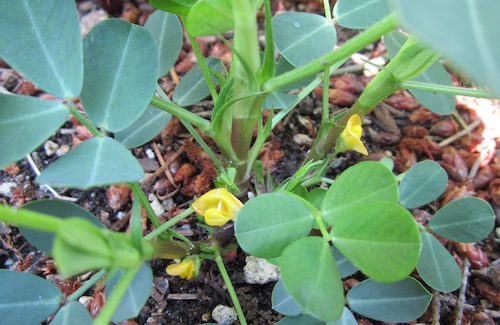
Peanut flowers, July 24th; photo by ALJ
|
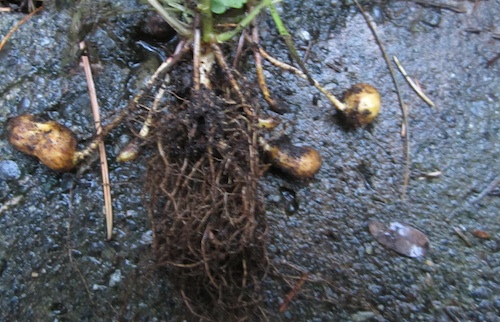
rootbound Peanut plant, November 17th; photo by ALJ
|
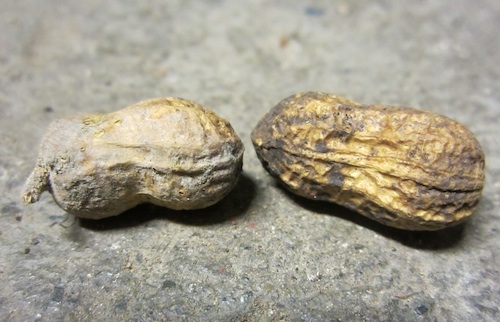
cured Peanut crop, December 9th; photo by ALJ
|

